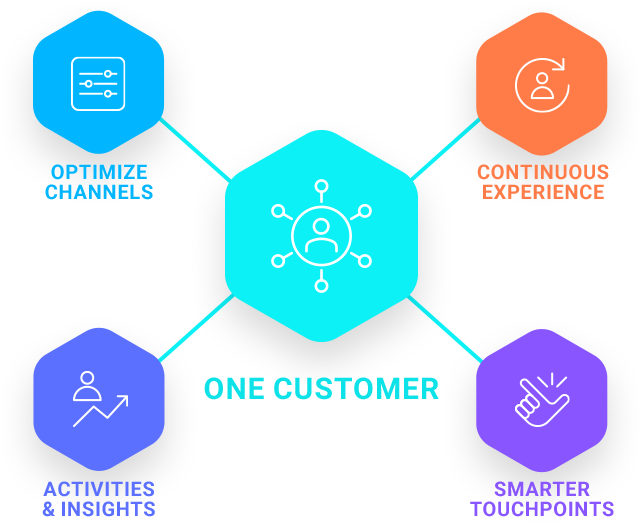How To Leverage Customer Experience Insights for More Integrated Marketing
The Information Age is over. Welcome to the Experience Age. In a world where customer experience (and satisfaction) with a brand lends a competitive advantage to rival the product itself, companies must prioritize strategies for shaping customer perception via carefully crafted interactions. This is what makes customer experience insights vital. Let’s take a look at how you can use them to build a more integrated marketing approach.
Customer Experience Insights
First, let’s start with customer experience.
Customer experience can be broadly defined as how your customers feel about your business and its brand throughout every interaction, digital and offline, during their entire relationship with your company.
This experience is informed by a web of connected interactions that the customer views as a continuous conversation with a single entity: your brand. Whether customer service was excellent, or the checkout process is a pain in the neck, consumers will tag your brand as the cause. Therefore, companies must strive for a consistent and positive journey across all possible channels and touchpoints.
It’s not as impossible as it sounds. Customer experience can be optimized both for individual clients and larger audiences alike by implementing a data-driven strategy built on customer insights.
Think of customer insights as windows into the world of your consumers, providing you a glimpse at the motivation that lies behind their choices and behavior. A deluge of data may explain what the customer did, but it takes insight to understand why they act the way they do.
Customer insights enable brands to:
- Understand customer behavior and attitude
- Predict product acceptance
- Anticipate consumer expectations
- Locate and address pain points
- Build loyalty and reduce churn
Without insights, a customer experience strategy is reduced to guesswork and reliance on whatever has worked in the past. A lack of customer insights precludes a consumer-centric culture by putting business agendas at the frontlines of the buyer’s journey rather than the buyer. This contrasts directly with a business that works in sync with its consumer-facing teams to win loyalty by serving customer needs first.
Where To Apply Customer Experience Insights
Increasingly, the customer journey takes place in a digital landscape dotted with hundreds of touchpoints. Customer experience insights can be especially helpful in creating a positive journey when leveraged at these critical points:

Marketing Communications
Engagement. Fine-tune individual journeys right from the start. Using insights gleaned from analyzing numerous other journeys and audience segmentation, marketers can choose the right messaging and ads to capture a lead’s interest.
Touchpoints. Knowing which touchpoints generate the best results helps marketers allocate resources wisely. Customer experience insights help calibrate this strategy for audience segments as well as individual levels.
Timing. There’s an art to timing that can transform relationships. Without customer experience insights, marketers and brands risk alienating loyal customers. On the other hand, a well-timed message may be just what an interested buyer needs to hear to complete their purchase, if your strategy determines the best time of day week to engage them.
Support
Customer experience at the support level is particularly instrumental to stopping churn in its tracks. When clients see support teams who understand and meet their needs, they are likely to reciprocate with loyalty-driven actions like repeat purchases or advocacy.
Support staff can use audience-level customer insights to serve individual clients based on similar interactions. Insights from historical trends and patterns of behavior also enable support teams to anticipate customers’ needs from the point of purchase forward.
Take, for example, a customer who purchases a next-generation appliance model and calls support to ask about setup. After answering inquiries, the support personnel might offer the customer a low-cost warranty extension instead of the usual accessories. This scenario is based on insights that suggest first-time buyers anxious about investing in new technology may prefer longer purchase guarantees to shiny new add-ons. Such examples demonstrate how customer insights can add value to customer journeys at the support stage.
Pain Points
Providing a perfect customer journey for every individual is a tall order for any brand. But companies can create the best experience possible at touchpoints that matter. Again, customer experience insights come into play when alleviating pain points in any consumer’s journey.
Some common pain points include:
Checkout process. Checkout woes seem to multiply along with the proliferation of digital platforms. Brands can use insights to diagnose problems with online or mobile checkout processes, like limited payment options, overly long checkouts, or slow loading times.
Slow support. Internal reports rarely coincide with customer perceptions, especially when it comes to customer support. Customer experience insights can highlight areas for improvement such as slow response times, unavailable personnel, and redundant or confusing steps to solve common problems.
Delivery. Customers want to be able to keep track of their purchase, from the moment they click ‘buy’ to the minute it arrives on their doorstep. Brands can apply customer experience insights to keep buyers happy and resolve pain points on delivery options, delivery times, or tracking services.
Treasure Data Transforms Your Data Into Customer Experience Insights
Consider the following findings from Mitto and Demand Metric’s 2021 report “The State of Customer Experience”:
- Companies with a complete omnichannel strategy are 2x more likely to respond quickly to customer inquiries in real time or within the hour
- 4x more likely to say they have “extremely loyal customers”
- 3x more likely to report higher revenue over the last 12 months
- More likely to report higher average customer satisfaction scores (CSAT)
These and other findings show a clear correlation between an omnichannel strategy and a stellar customer experience. Brands need to have a consistent message and integrated marketing approach across all channels and touchpoints.
A Customer Data Platform like Treasure Data’s gives brands the tools to make this happen. With identity resolution, intelligent customer experience insights, and journey orchestration, Treasure Data helps brands stand out in the Experience Age.
Identity Resolution
Treasure Data’s Customer Data Platform (CDP) collects customer information from online and offline sources. The platform then stitches related information to resolve customer identities and create a unified view of each individual. These unified profiles make up a customer data foundation which becomes the source of truth for marketing, sales, and support teams.
Treasure Data’s enterprise CDP is capable of maintaining customer profiles on a global scale thanks to the following capabilities:
- Unlimited cloud storage capacity
- Flexible ingestion, with 170+ connectors for martech and business SaaS apps
- 2 million records ingested per second
- 40 billion profiles activated per month
- Optimization of experiences using Profiles API in real time
These, along with other unique features, are the key to helping brands create cohesive customer journeys.
Intelligent Customer Experience Insights
Treasure Data uses Machine Learning to learn more about your customers and their journey. Predictive Scoring enables you to identify which customers are:
– Likely to buy
– Likely to churn
– Likely to respond to an offer
– Likely to convert
In addition, Treasure Data employs a Multi-Touch Attribution model to determine which marketing channels make the most significant contributions to successful customer journeys. By the same token, the MTA model also helps identify which channels produce negative customer experiences.
Journey Orchestration
Finally, Treasure Data layers a brand’s omnichannel strategy with intelligent insights for a more integrated marketing approach.
With Treasure Data Journey Orchestration, marketers can:
- Optimize channels according to customer experience insights
- Connect activities and insights across channels including website visits, support calls, email responses, and others
- Use insights to inform all touchpoints dynamically (web, online, mobile, etc.) for a continuously relevant conversation
- Orchestrate omnichannel campaigns based on customer buying stage, activity, and channels used
The result is a consumer-centric marketing strategy that connects relevant campaigns and channels to real-time action and behavior. Instead of forcing leads into an artificial funnel filled with irrelevant marketing actions, the customer journey unfolds around the individual’s decisions and preferences with carefully catered experiences.
Treasure Data takes the journey further with Next Best Action (NBA) recommendations. NBA is based on deterministic and probabilistic models that suggest an action with the highest chance of eliciting a customer’s positive response. Treasure Data’s NBA recommendation system disseminates customer experience insights to marketing, service, and sales teams in real time for the best results.
Watch Treasure Data Enterprise Customer Data Platform Demo below:
Activate Your Customer Experience Insights
Treasure Data provides brands with actionable insights for a winning customer experience strategy. Our AI and Machine Learning capabilities provide deep insights to personalize customer journeys at individual and segment levels. With Treasure Data, you can quickly visualize data insights and respond to critical trends for maximum impact.
To learn how to leverage customer experience insights that improve your marketing strategy, consult an expert today. Want to learn more? Request a demo, call 1.866.899.5386, or contact us for more information.
